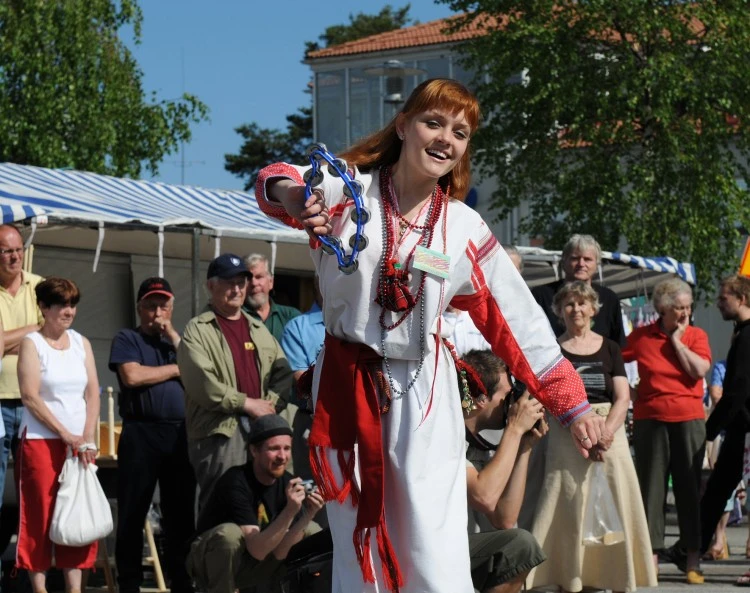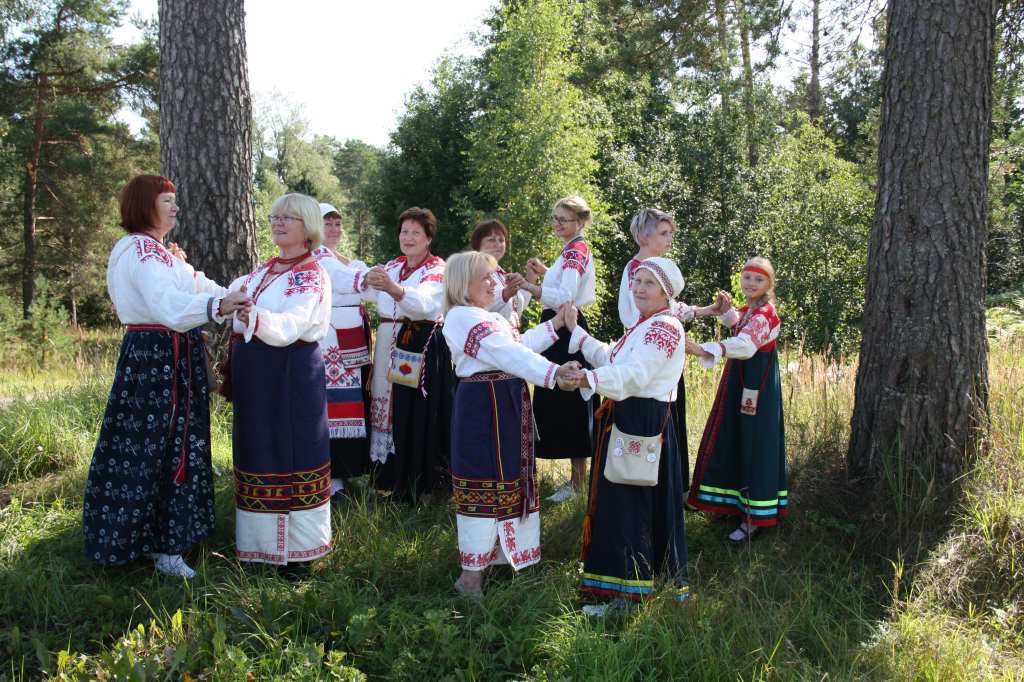The Izhorians (sg. ižoralaine, inkeroine, ižora, ingermans, ingers, ingrian), along with the Votes are an indigenous people of Ingria. Small numbers can still be found in the Western part of Ingria, between the Narva and Neva rivers in northwestern Russia. The history of the Izhorians is bound to the history of Ingria. It is supposed that shortly after 1000, the Izhorians moved from Karelia to the west and south-west. In 1478, the Novgorod Republic, where Ingrians had settled, was united with the Grand Duchy of Moscow, and some of the Izhorians were transferred to the east. The establishment of St Petersburg in 1703 had a great influence on Izhorian culture. Deportations in 1929–1931 dramatically changed the demographics of Ingria. World War II had the biggest impact on Izhorian culture, as devastating battles.
In 1848, P. von Köppen counted 17,800 Izhorians, and by 1926 there were 26,137 Izhorians in the Russian SFSR. In the 1959 census, however, only 1,100 Izhorians were counted in the USSR. In 1989, 820 self-designated Izhorians, 302 of whom were speakers of the Ingrian language were registered. 449 Izhorians lived in the territory of the USSR. According to the 2002 Russian Census, there were 327 Izhorians in Russia, of whom 177 lived in Leningrad oblast and 53 in St Petersburg. There were also 812 Ingrians in Ukraine according to Ukrainian Census (2001) (more than in Russian Federation and Estonia altogether) and a further 358 Ingrians in Estonia.

The Izhorians (Russian: Ижо́ра; ижо́рцы; sg. inkerikot, isurit, ižoralaine, inkeroine, ižora, ingermans, ingers, ingrian, pl. ižoralaizet), along with the Votes, are an indigenous people of Ingria. Small numbers can still be found in the western part of Ingria, between the Narva and Neva rivers in northwestern Russia. The history of the Izhorians is bound to the history of Ingria. It is supposed that shortly after 1000 AD the Izhorians moved from Karelia to the west and south-west. In 1478, the Novgorod Republic, where Ingrians had settled, was united with the Grand Duchy of Moscow, and some of the Izhorians were transferred to the east. The establishment of St Petersburg in 1703 had a great influence on Izhorian culture. World War II had the biggest impact on Izhorians, as devastating battles (such as the Siege of Leningrad) took place on their territory. Large numbers of Izhorians perished during World War II, so in honour of them the “Izhorians’s battalion” was named after them (created of volunteers for the defense of St-Petersburg).

The Izhorians (Russian: Ижо́ра;ижо́рцы; Finnish: inkerikot; Estonian: isurid; sg. ižoralain, inkeroin, ižora, ingermans, ingers, ingrian, pl. ižoralaizet), along with the Votes, are a Finnic indigenous people native to Ingria. Small numbers can still be found in the western part of Ingria, between the Narva and Neva rivers in northwestern Russia. Although in English oftentimes sharing a common name with the Finns of Ingria, these two groups are distinct from one another. The history of the Izhorians is bound to the history of Ingria. It is supposed that shortly after 1000 AD the Izhorians moved from Karelia to the west and south-west. In 1478, the Novgorod Republic, where Ingrians had settled, was united with the Grand Duchy of Moscow, and some of the Izhorians were transferred to the east. The establishment of St Petersburg in 1703 had a great influence on Izhorian culture. World War II had the biggest impact on Izhorians, as devastating battles (such as the Siege of Leningrad) took place on their territory.

Ingrian (ižoran keeli[ˈiʒorɑŋ ˈkeːli] or inkeroin keeliIPA: [ˈiŋkeroi̯ŋ ˈkeːli]), also called Izhorian, is a nearly extinct Finnic language spoken by the (mainly Orthodox) Izhorians of Ingria. It has approximately 120 native speakers left, all of whom are elderly. The Ingrian language should be distinguished from the Ingrian dialect of the Finnish language, which became the majority language of Ingria in the 17th century with the influx of Lutheran Finnish immigrants; their descendants, the Ingrian Finns, are often referred to as Ingrians. The immigration of Lutheran Finns was promoted by Swedish authorities, who gained the area in 1617 from Russia, as the local population was (and remained) Orthodox.

The self-designations used are inkeroine-izhora-izhoralaine, ‘Izhorian‘, also karjalain ‘Karelian’ and maaväki ‘the Ingrian people’. The language is known as izhoran keeli ~ maakeeli. The Izhorians are descended from the Karelian tribes and even to this day they sometimes use the self-designation karjalain. The Ingrian territory has received its name from the southern tributary of the Neva, the Inkere, and according to some theories the Izhorian tribe has its origins in the valley of Inkere. The names izhora-izhoralaine, and the Estonian word isur come from the Russian version of the name of the river. Like the Estonians and the Votes, the Izhorians have also on occasion referred to themselves as ‘country people’ (maaväki). In written records the Izhorians have been mentioned from the 12th century on. In one of the papal bulls of Alexander III (ab. 1181–1195) in addition to the Karelians, the Lapps, and the Votes, “the pagans of Ingria” were also mentioned among those to whom it was forbidden to sell arms.

According to recent studies, the peoples speaking Finno-Ugric languages have inhabited Europe for about ten millennia. It seems that before the “Great Migration”, mainly Finno-Ugric languages were spoken in Eastern and Central Europe. Linguistic kindredness of Finno-Ugric peoples was discovered at the end of the 18th century by the Hungarian scholar János Sajnovics (1733-1785). These observations of the Hungarian theologian have led to the development of an entire branch of linguistics – Finno-Ugric studies – which in turn has extended into Uralic studies (linguistics of Uralic languages) which also comprises Samoyed languages. Sometimes the term “Finno-Ugric” refers to all Uralic peoples, including Samoyedic peoples. Today, almost 25 million people belong to the Uralic (i.e., Finno-Ugric and Samoyed) language family, inhabiting an area that extends from Norway in the West and the Ob River region in the East, to the lower reaches of the Danube in the South. Thus, various Finno-Ugric enclaves can be found in this massive domain that is surrounded by peoples speaking Germanic, Slavic, Romance and Turkic languages.

The self-designations used are inkeroine-izhora-izhoralaine, ‘Izhorian‘, also karjalain ‘Karelian’ and maaväki ‘the Ingrian people’. The language is known as izhoran keeli ~ maakeeli. The Izhorians are descended from the Karelian tribes and even to this day they sometimes use the self-designation karjalain. The Ingrian territory has received its name from the southern tributary of the Neva, the Inkere, and according to some theories the Izhorian tribe has its origins in the valley of Inkere. The names izhora-izhoralaine, and the Estonian word isur come from the Russian version of the name of the river. Like the Estonians and the Votes, the Izhorians have also on occasion referred to themselves as ‘country people’ (maaväki). In written records the Izhorians have been mentioned from the 12th century on. In one of the papal bulls of Alexander III (ab. 1181–1195) in addition to the Karelians, the Lapps, and the Votes, “the pagans of Ingria” were also mentioned among those to whom it was forbidden to sell arms.

Ingrians refer themselves ‘inkeriläinen’ (Ingrian) or ‘Inkerin suomalainen’ (Ingrian Finn) after the historical Ingria. Their common identity was formed in the 19th century, when the Savakot and Äyrämöiset who emigrated from southeastern Finland in the 17th century perceived an affinity with the Finns of Finland. In the Soviet Union, Ingrians were also called ‘leningradskiye finny‘ (Leningrad Finns). According to the 2010 Census, 20 267 Finns, including Ingrians, lived in Russia. In 2002, the number of Finns was 40.48% higher or 34 050. Population decline has been drastic, including due to the resettlement of many Ingrian Finns to their historical homeland in Finland. When in the 1990s Ingrian Finns were given the right to resettle to Finland, 20 000 persons took advantage of this opportunity within just 10 years. In 1989, 67 359 Finns lived in the Soviet Union, of whom 34.6% spoke the mother tongue. In broad terms, a quarter of them lived in Karelia, another quarter in Estonia, third quarter in Leningrad Oblast and the rest elsewhere in the USSR. Since 1939, the number of Ingrians has not been disaggregated from all Finns. In 1989, Finns made up approximately 1% of the population of Leningrad Oblast (without St. Petersburg).

History of the Izhorian people
It is important to remember that Izhorians, an indigenous Finno-Ugrian ethnic group populating the Leningrad region, should not be confused with Ingermanland Finns (also known as Ingrian Finns), who largely migrated to the area in the
seventeenth century. What separates these ethnic groups, which speak similar languages, is religion: Izhorians are Orthodox, and Ingrian Finns are Lutheran. On the other hand, the history of Izhorians, especially in the twentieth century, cannot be considered separately from that of Ingermanland Finns, as they both suffered enormously from persecution and ethnic cleansing during the Soviet period. The Treaty of Stolbovo, a peace treaty of 1617 that ended the seven-year Ingrian War between Sweden and Russia, was a major factor that set in motion cultural and linguistic interactions between Izhorians and Ingrian Finns. According to its provisions, “the Russian territory south of the Gulf of Finland and along
both banks of the Neva River was transferred to Sweden and became known as the Swedish province of Ingermanland (Ingria)” (Кирьянен et al., 2017, p. 131, trans. EF). Finnish peasants had been slowly migrating to this area since the end of the sixteenth century, but the treaty legalised this process and encouraged further migration, mainly from areas of the modern Vyborg and Priozersk districts, the Northern Ladoga area and the south-eastern part of modern Finland (Кирьянен, 2016).

The self-designations are inkeriläinen and inkerin suomalainen ‘the Ingrian, the Ingrian Finn’ and they call their language (inkerin) suomen kieli. The self-designation inkerin suomalaiset began to spread in the 19th century when under the influence of Lutheranism and scoolteaching in Finnish, a feeling of unity developed with the Finns of Finland. As the Ingrian may signify an inhabitant of Ingermanland in general the more precise distinction is made between the peoples. Inkeroinen and inkerikko signify the Izhorians in Finnish and inkeriläinen first of all the Ingrians. The equivalent of the Izhorian in Russian is ижорец and ижора and the Ingrian — ингерманландский финн or, according to the region, ленинградский финн. The designation originates from the River Inkere (Izhora) that has probably given its name to the whole country. Other inhabitants of historic Ingermanland are the Votes.






